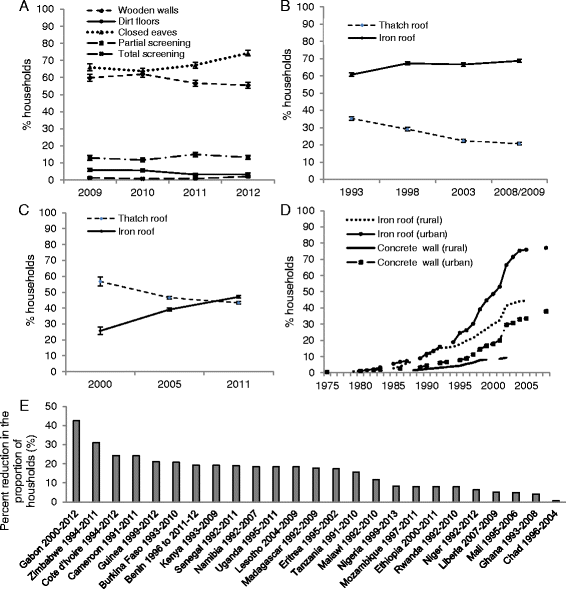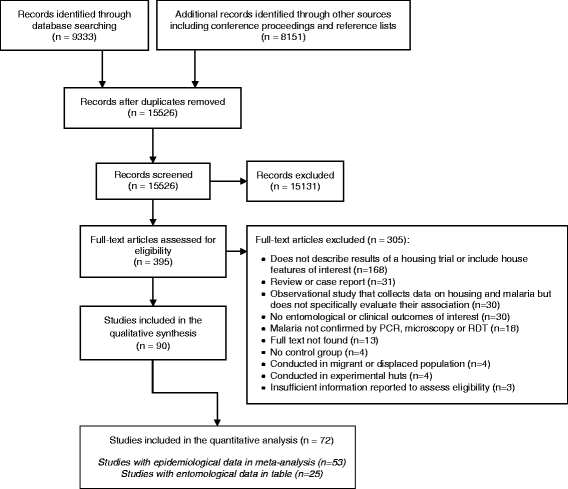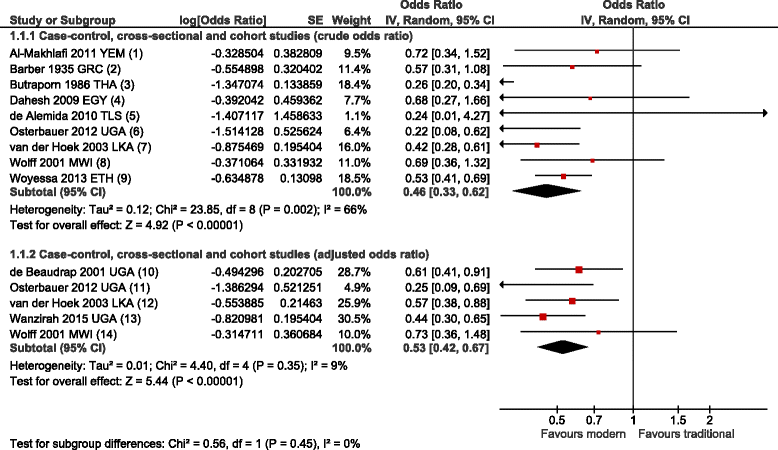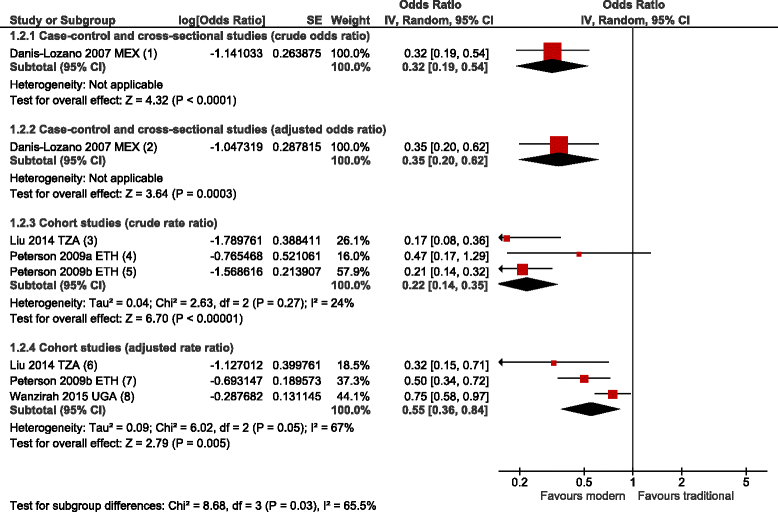The evidence for improving housing to reduce malaria: a systematic review and meta-analysis
- PMID: 26055986
- PMCID: PMC4460721
- DOI: 10.1186/s12936-015-0724-1
The evidence for improving housing to reduce malaria: a systematic review and meta-analysis
Abstract
Background: The global malaria burden has fallen since 2000, sometimes before large-scale vector control programmes were initiated. While long-lasting insecticide-treated nets and indoor residual spraying are highly effective interventions, this study tests the hypothesis that improved housing can reduce malaria by decreasing house entry by malaria mosquitoes.
Methods: A systematic review and meta-analysis was conducted to assess whether modern housing is associated with a lower risk of malaria than traditional housing, across all age groups and malaria-endemic settings. Six electronic databases were searched to identify intervention and observational studies published from 1 January, 1900 to 13 December, 2013, measuring the association between house design and malaria. The primary outcome measures were parasite prevalence and incidence of clinical malaria. Crude and adjusted effects were combined in fixed- and random-effects meta-analyses, with sub-group analyses for: overall house type (traditional versus modern housing); screening; main wall, roof and floor materials; eave type; ceilings and elevation.
Results: Of 15,526 studies screened, 90 were included in a qualitative synthesis and 53 reported epidemiological outcomes, included in a meta-analysis. Of these, 39 (74%) showed trends towards a lower risk of epidemiological outcomes associated with improved house features. Of studies assessing the relationship between modern housing and malaria infection (n=11) and clinical malaria (n=5), all were observational, with very low to low quality evidence. Residents of modern houses had 47% lower odds of malaria infection compared to traditional houses (adjusted odds ratio (OR) 0°53, 95% confidence intervals (CI) 0°42-0°67, p< 0°001, five studies) and a 45-65% lower odds of clinical malaria (case-control studies: adjusted OR 0°35, 95 % CI 0°20-0°62, p<0°001, one study; cohort studies: adjusted rate ratio 0°55, 95% CI 0°36-0°84, p=0°005, three studies). Evidence of a high risk of bias was found within studies.
Conclusions: Despite low quality evidence, the direction and consistency of effects indicate that housing is an important risk factor for malaria. Future research should evaluate the protective effect of specific house features and incremental housing improvements associated with socio-economic development.
Figures




Similar articles
-
The effects of modern housing on malaria transmission in different endemic zones: a systematic review and meta-analysis.Malar J. 2024 Aug 7;23(1):235. doi: 10.1186/s12936-024-05059-x. Malar J. 2024. PMID: 39113048 Free PMC article. Review.
-
Rapid improvements to rural Ugandan housing and their association with malaria from intense to reduced transmission: a cohort study.Lancet Planet Health. 2018 Feb;2(2):e83-e94. doi: 10.1016/S2542-5196(18)30010-X. Epub 2018 Feb 9. Lancet Planet Health. 2018. PMID: 29615240 Free PMC article.
-
Folic acid supplementation and malaria susceptibility and severity among people taking antifolate antimalarial drugs in endemic areas.Cochrane Database Syst Rev. 2022 Feb 1;2(2022):CD014217. doi: 10.1002/14651858.CD014217. Cochrane Database Syst Rev. 2022. PMID: 36321557 Free PMC article.
-
Randomized trials of housing interventions to prevent malaria and Aedes-transmitted diseases: A systematic review and meta-analysis.PLoS One. 2021 Jan 8;16(1):e0244284. doi: 10.1371/journal.pone.0244284. eCollection 2021. PLoS One. 2021. PMID: 33417600 Free PMC article.
-
Mosquito aquatic habitat modification and manipulation interventions to control malaria.Cochrane Database Syst Rev. 2022 Nov 11;11(11):CD008923. doi: 10.1002/14651858.CD008923.pub3. Cochrane Database Syst Rev. 2022. PMID: 36367444 Free PMC article. Review.
Cited by
-
From the Ground Up: Stakeholder Perspectives on Housing Interventions to Reduce Environmentally Mediated Infections.medRxiv [Preprint]. 2024 Sep 19:2024.09.17.24313843. doi: 10.1101/2024.09.17.24313843. medRxiv. 2024. PMID: 39371156 Free PMC article. Preprint.
-
Impact of blood meals taken on ivermectin-treated livestock on survival and egg production of the malaria vector Anopheles coluzzii under laboratory conditions.PLoS One. 2024 Aug 15;19(8):e0308293. doi: 10.1371/journal.pone.0308293. eCollection 2024. PLoS One. 2024. PMID: 39146278 Free PMC article.
-
The effects of modern housing on malaria transmission in different endemic zones: a systematic review and meta-analysis.Malar J. 2024 Aug 7;23(1):235. doi: 10.1186/s12936-024-05059-x. Malar J. 2024. PMID: 39113048 Free PMC article. Review.
-
The Uganda housing modification study - association between housing characteristics and malaria burden in a moderate to high transmission setting in Uganda.Malar J. 2024 Jul 30;23(1):223. doi: 10.1186/s12936-024-05051-5. Malar J. 2024. PMID: 39080697 Free PMC article.
-
Living Conditions and Malaria: A Longitudinal Study in a Rural Malaria-Endemic Area of Sri Lanka.Am J Trop Med Hyg. 2024 Jun 18;111(2):317-323. doi: 10.4269/ajtmh.22-0688. Print 2024 Aug 7. Am J Trop Med Hyg. 2024. PMID: 38889733
References
-
- WHO . World Malaria Report. Geneva: World Health Organization; 2014.
Publication types
MeSH terms
Grants and funding
LinkOut - more resources
Full Text Sources
Other Literature Sources
Medical

